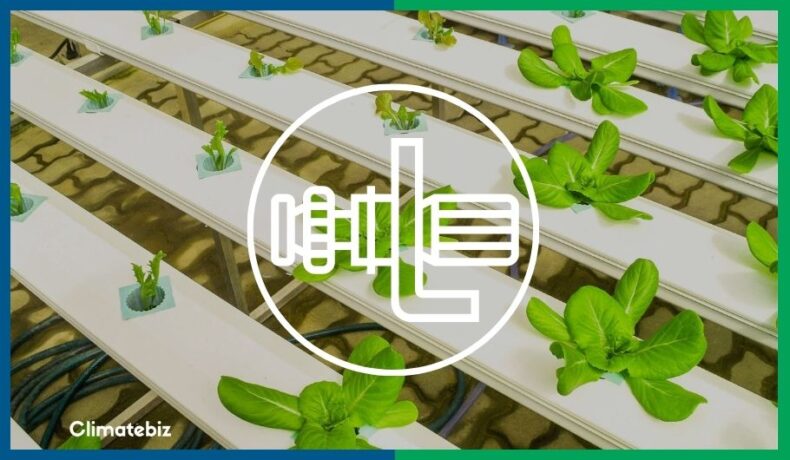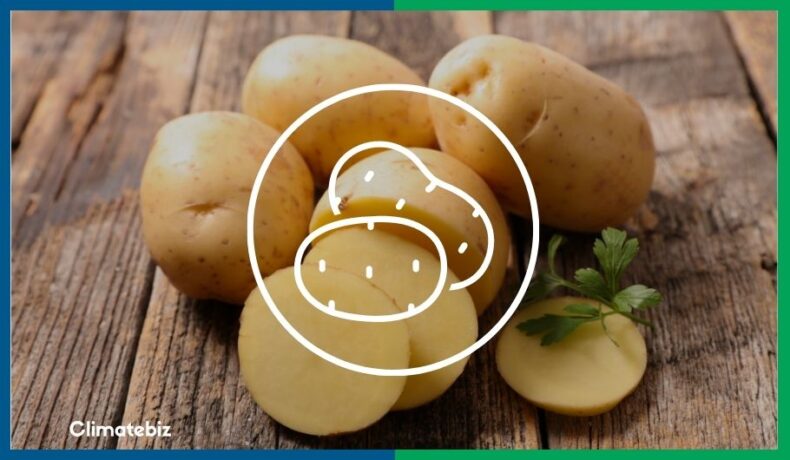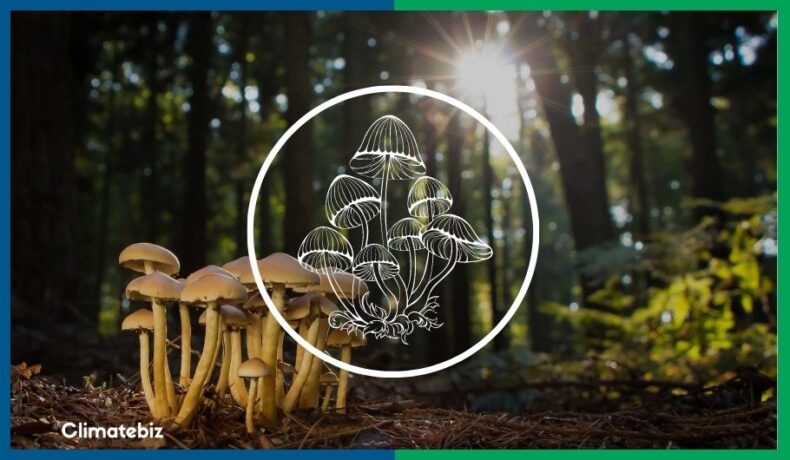
Hydroponics and mushrooms are not exactly two terms you’d expect to go together. But while this may leave gardening enthusiasts a tad skeptical, hydroponic mushrooms are the real deal.
What’s more — and let’s be honest here — most people view mushrooms as no more than dung-dwelling, fungi that live in the dark, requiring little in the way of care.
But that’s not the case; there is a lot more to these little guys than you might think.
In this article, we’ll take a look into the world of hydroponically grown mushrooms, and in fact, mushrooms as a whole. We’ll uncover more about their life cycle, what nutrients they require and settle the debate as to whether they require light or not.
Affiliate Disclaimer
Table of Contents
What Are Hydroponic Mushrooms?
Hydroponic mushrooms are simply mushrooms that have been grown in a hydroponic system.
In case you’ve forgotten:
Hydroponic growing uses a nutrient-rich, water-based solution in place of soil as a growing medium for plant propagation.
With this method, nutrients added to the solution are fed directly to your plants.
This allows your plants to access ample amounts of oxygen, allowing for greater quality produce and noticeably less time between yields.
There’s A Catch
Mushrooms aren’t exactly plants, now are they? They’re fungi. So the real question is, can they be grown hydroponically, and if so, how?
How Are Mushrooms Grown Hydroponically?
To fully grasp how mushrooms can be grown hydroponically, you’ll need to have a basic understanding of their lifecycle.
Mushroom-Producing Life Cycle
First and foremost, it’s essential to understand that mushrooms reproduce via microscopic spores. When large amounts of these spores are together, they carry the appearance of dust.
Vegetative Stage
When these spores separate from a mushroom and come into contact with organic matter (or if you had to inoculate them yourself directly), they will germinate into threads of cells called hyphae. For this to happen, an appropriate amount of moisture and nutrients need to be present, and the temperature must be just right.
As these strands of hyphae grow, they branch neighboring hyphae strands of compatible spores. As a result, they form an interconnected, filamentous mat known as mycelium.
Imagine if you will, the branches of a tree or a system of roots — this is what a collection of hyphae looks like.
We’ll refer to the growth of mycelium as the vegetative growth of fungi. The fungal cells come together from these mycelial mats to form pinheads — these are baby mushrooms.
Fruiting Stage
Under the right conditions, these pinheads will grow into fully-formed mushrooms. We’ll call this the fruiting stage.
To put this all into perspective, the mushroom that you’re able to see above ground is the sex organ (fruiting body) of the mycelium.

Source: Forest Origins
The Basics Of Hydroponically Grown Mushrooms
Mushroom spores, much like plant seeds in regular hydroponic setups, require growing substrate.
This growing medium is inoculated/infused with spores, after which mycelium will begin to develop, fuse, and colonize the substrate.
However, in order for this to happen, the growing medium must contain nutrients in some form. This is because mushrooms, unlike plants, cannot make their own food.
Nutrients that are given to the fungi are consumed for energy purposes. In other words, mushrooms require some form of carbohydrate or sugar to grow and develop.
A growing medium that many people use for this purpose is vermiculite. This source of nutrients is usually mixed with brown rice flour and small amounts of water to form a sterilized cake of sorts.
Hydroponic Setup Components
So how would you go about applying these sterilized cakes to a hydro setup, and what would a hydroponic mushroom system look like?
A hydroponic mushroom system would consist of the following:
- A reservoir/container
- Expanded clay pebbles
- A water heater
- Humidity gauge
- Light
- Air pump with an airstone
The Process
You’ll place the water heater and air stone at the bottom of your tank and cover it with the expanded clay pebbles. Then you’ll submerge everything in the water and place your inoculated vermiculite cakes on top.
Following this, you’ll use the air filter to pump air via the air stone to oxygenate the water while it is heated to temperature.
Until such time that your setup can coax the mycelium into fruiting successfully, you’ll need to give your humidity levels above 70% and provide your mushrooms with light – if/when they need it.
Which Grow Kits Are Best For Hydroponic Mushrooms?
While you can go the DIY route with hydroponic mushrooms, you can also purchase mushroom grow kits — much like you would with plant hydroponic kits. In fact, most people tend to go this route as it takes the hassle out of sourcing the appropriate components.
Here are three mushroom growing kits you can use to kick start your mushroom venture:
Back to the Roots – Organic and Golden Oyster Mushroom Grow Kit
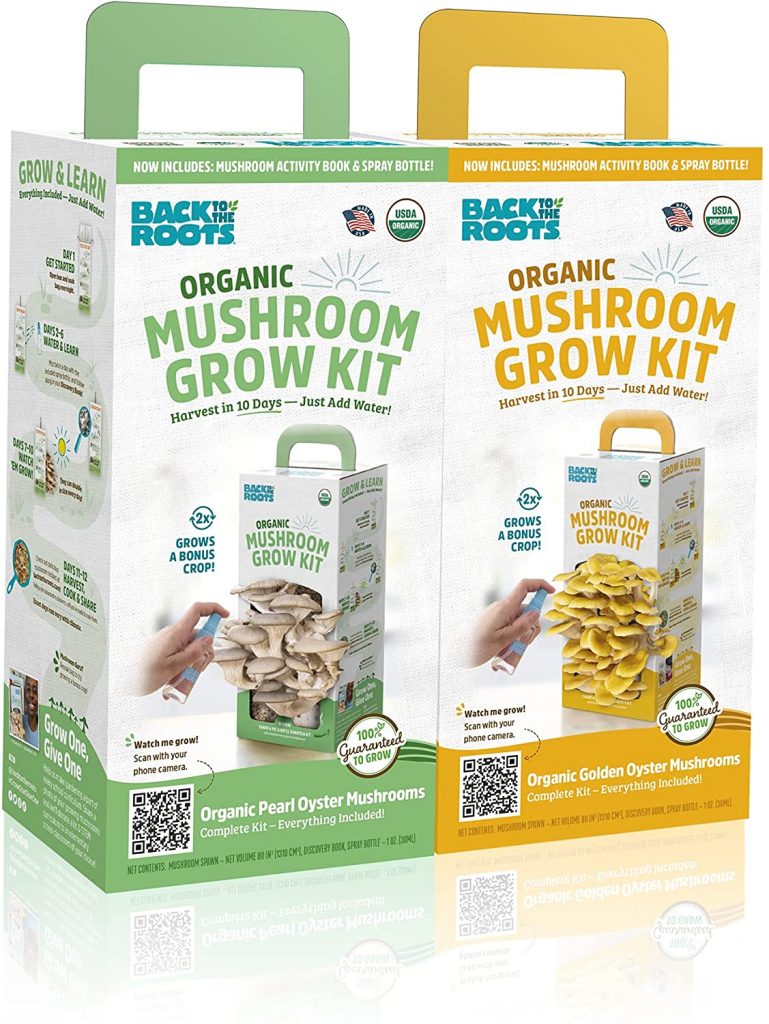
This grow kit will allow you to cultivate mushrooms all year round.
All you need to do is place the box near a window with indirect light and mist twice a day.
Each crop produces three to four servings of mushrooms, and each box can grow up two crops.
View Price
Out Grow – Mushroom Grow Kit
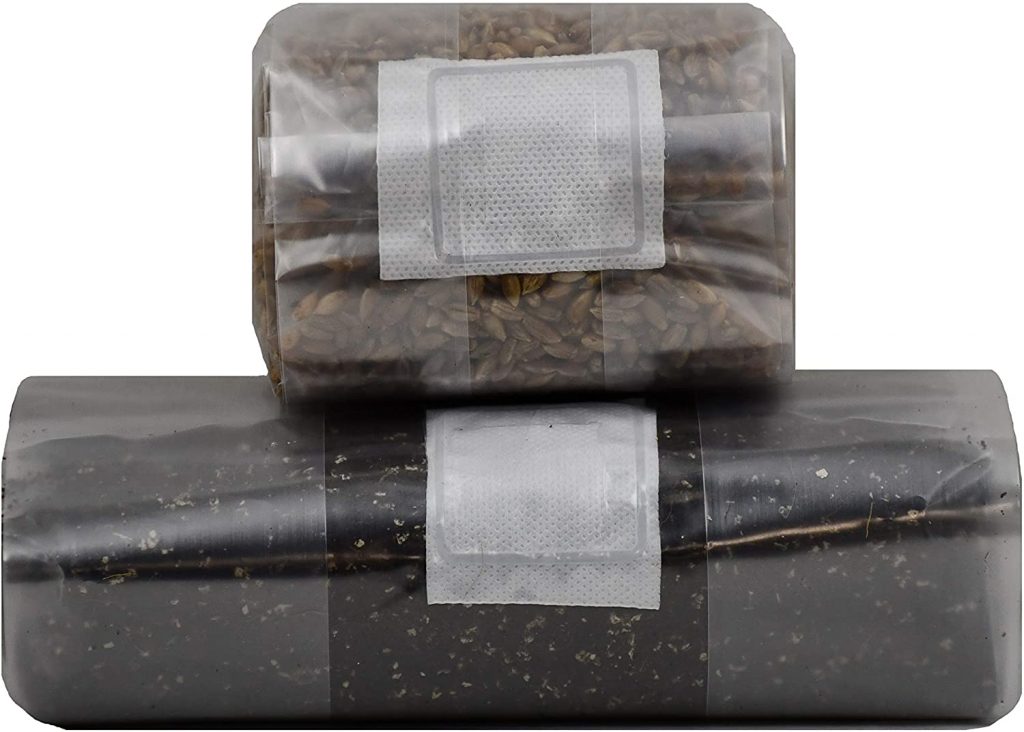
This quick kit is fantastic for small or test grows, making it suitable for both novices and more experienced growers.
The kit comes with 2 pre-sterilized mushroom substrates, a one-pound bag of hydrated and sterilized organic rye berries to make your spawn with, and a one-pound bag of horse manure-based mushroom substrate to use as your bulk substrate.
2FunGuys – 12″ Oyster Mushrooms Mushroom Log DIY
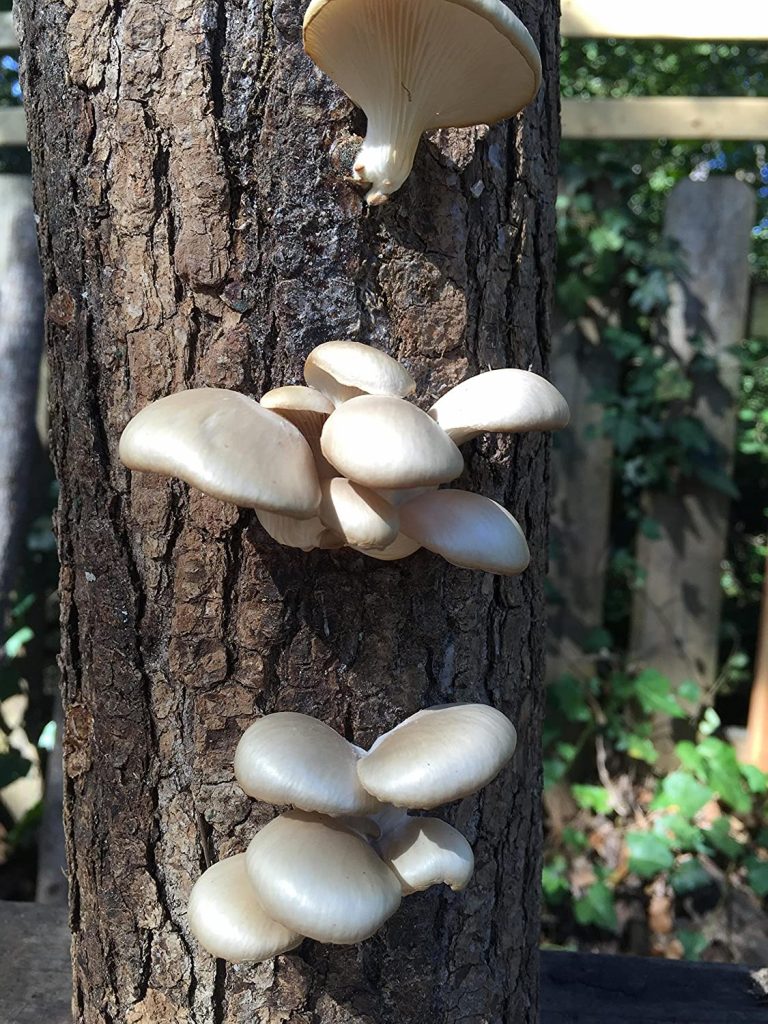
Many species of mushrooms love to grow on logs.
This kit provides you with logs that are hand-cut and inoculated with Oyster mushroom spores in visible drill holes that are covered in cheese wax.
Within weeks you’ll be able to harvest your very own crop of organic mushrooms
Simply soak the log for 24 hours in cold water, mist it occasionally, and watch your crop emerge once the inoculation period is reached.
Best Nutrients For Hydroponic Mushrooms
Unlike hydroponically grown basil or avocado, mushrooms cannot produce their own food. Therefore, the nutrients you give your mushrooms will act as their primary source of food/energy.
At the very least, mushrooms require the following:
- Fat
- Lignin
- Nitrogen
- Sugar
- Starch
- Protein
Substrates For Hydroponic Mushrooms
You can find elements in substrates.
A substrate is a bulk material that mushroom mycelium can grow on, gain energy and nutrition, and eventually produce fruit mushrooms.
The best mushroom substrate can vary depending on the type of mushroom you’re trying to grow. Generally, though, they consist of a base organic material that the mushroom will use for energy. Add to this a little bit of extra nutrition and a lot of water, and there you have it, the perfect mushroom growing concoction.
Substrate Examples
Most people out there assume that all mushrooms grow in manure, but that simply isn’t the case. A lot of them actually prefer hardwood.
Let’s have a look at some substrates suitable for mushrooms that are low in nutrition (substrates that are low in nutrition require pasteurization, not sterilization):
- Wheat straw
- Wood shavings (aspen or oak are best)
- Coco choir
Now let’s look at some substrates high in nutrition (substrates high in nutrition require sterilization):
- Hardwood fuel pellets
- Soy hulls
For those of you who may feel a little confused about the difference between pasteurization and sterilization, here’s a comprehensive video explaining the difference between the two:
Do Hydroponic Mushrooms Need a Grow Light?
After reading this question, you may be thinking to yourself, “Surely not; mushrooms are fungi; they don’t have chlorophyll like plants do, so why would they need it?”
Yes, it is true that mushrooms don’t have chlorophyll. As such, they don’t photosynthesize. But there are types of mushrooms that rely on light. At the very least, certain mushrooms require light at particular stages of their growth cycle.
In 1980, when discussing blue-light photomorphogenesis (the process by which plants grow and develop in response to light signals, Eger-Hummel states, “In regard to light, four types of mushroom can be distinguished”.
These 4 groups are:
Group A
Light and darkness play no role at any stage of fruiting body development.
Group B
Light and darkness play no role in primordium formation, but light is required at later stages of mushroom development.
Group C
Light is required except for a short period at an early stage of development when darkness is essential.
Group D
Light is needed for all stages of fruiting body development.
Note: The below illustration demonstrates when light and darkness should be present throughout the growth cycle of each mushroom group.
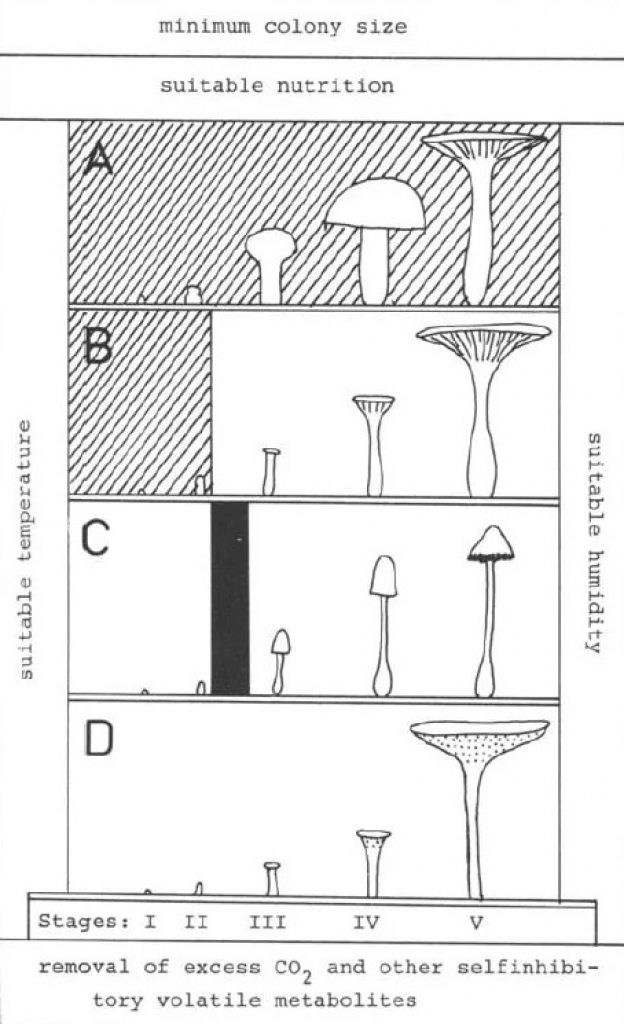
Truthfully though, the situation is a little more complicated.
Not every mushroom falls under one of these four groups. Mushrooms from one group can in fact belong to another after being conditioned to grow in a particular way.
Examples Of How Light Can Affect Different Mushroom Species
In the table below, you’ll see which spectrum of light (red, green & blue) is best for the growth of the following mushroom species at their respective stages of growth.
The mushroom species are:
- Shiitake Mushroom (Lentunila Edodes)
- Oyster Mushroom (Pleurotus Ostreatus)
The growth stages are as follows:
- Mycelium
- Spore Germination
- Fruiting Body
| Mushroom species | Mushroom phase | Treatment | Result |
| Shiitake Mushroom | Mycelium | Dark, Red (645), Green (515), Blue (465) Exposure time: 0, 1, 5, 30, 60 min/day Light intensity: 0.44, 0.88, 1.77, 3.10, 6.66 W/m² | Green > Blue > Red > Dark. |
| Oyster Mushroom | Mycelium | Red, Green, Blue, control 5, 10, 15, 20 s | Best growth: Green light. |
| Shiitake Mushroom | Spore germination | Red (632.8), Green (514.5), Blue (488) 45, 230, 650 mJ/cm² | Best growth: Red light. Green suppresses growth. Blue suppresses growth for some species. No difference between continuous and intermittent illumination. |
| Oyster Mushroom | Spore germination | Red (632.8), Green (514.5), Blue (488) 45, 230, 650 mJ/cm² | Best growth: Red light. Green light suppresses growth. Blue light suppresses growth for some species. No difference between continuous and intermittent illumination. |
| Shiitake Mushroom | Fruiting Body | 9/15 (on/off) Different light sources | Low Ca-medium Red light: Highest #of primordia Highest #of fruiting bodies High Ca-medium Red: not sufficient Blue: required. |
| Oyster Mushroom | Fruiting Body | Blue (440), Red (660 or 720), or Blue + Red | Highest yield Blue + Red. |
Final Thoughts
Mushrooms sure are fascinating little fungi. After reading this article, we’re confident that you have a much better understanding and appreciation of what makes them tick.
Not only that, you now know that it’s possible to grow these little guys at home, either through hydroponic means or via mushroom grow kits.
At the end of the day, who doesn’t love a good mushroom? They make a tasty, nutritious, and versatile addition to any dish.
Some are even saying that mushrooms are the next meat!



